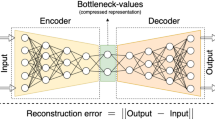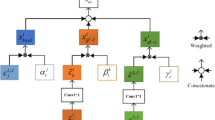Abstract
Elevated road plays a very important role as corridors in urban traffic network, and the occurrence of traffic accidents often causes a great impact. In that sense, we propose a unique and enhanced Autoencoder (AE) to identify elevated road traffic accident (RTA) risk based on traffic anomaly detection in an unsupervised manner. An attention mechanism is introduced to extract the traffic condition features considering traffic spatiotemporal variation characteristics. Additionally, an enhanced loss is also introduced to optimize the ability of unsupervised anomaly detection (UAD) approach to detect anomalous RTA risk and persistent anomalous traffic condition, which can significantly boost the anomaly detection performance using the contaminated traffic condition datasets. To assess the RTA risk, the evaluation mechanism and discriminant threshold are used to quantitatively analyze the detected abnormal traffic condition. Finally, experiments on real traffic datasets demonstrate the effectiveness of the model.














Similar content being viewed by others
References
Li H, Li Z, White RT, Wu X (2013) A real-time transportation prediction system. Appl Intell 39(4):793–804
Zhang H, Wang X, Cao J, Tang M, Guo Y (2018) A multivariate short-term traffic flow forecasting method based on wavelet analysis and seasonal time series. Appl Intell 48(10):3827–3838
Yakimov M (2020) Methods for assessing road traffic accident risks with changes in transport demand structure in cities. Transportation Research Procedia 50:727–734
Shah SAR, Ahmad N, Shen Y, Kamal MA, Basheer MA, Brijs T (2019) Relationship between road traffic features and accidents: an application of two-stage decision-making approach for transportation engineers. J Saf Res 69:201–215
Cheng Z (2021) et al. Improved autoencoder for unsupervised anomaly detection 36(12):7103–7125
Xu H, et al. (2018) Unsupervised anomaly detection via variational auto-encoder for seasonal KPIs in web applications, in Proceedings of the 2018 World Wide Web Conference. 2018, International world wide web conferences steering committee: Lyon, France p 187–196
Yu J, et al. (2021) Normality-calibrated autoencoder for unsupervised anomaly detection on data contamination
Vorko-Jović A, Kern J, Biloglav Z (2006) Risk factors in urban road traffic accidents. J Saf Res 37(1):93–98
Chen T-Y, Jou R-C (2019) Using HLM to investigate the relationship between traffic accident risk of private vehicles and public transportation. Transp Res A Policy Pract 119:148–161
Theofilatos A (2017) Incorporating real-time traffic and weather data to explore road accident likelihood and severity in urban arterials. J Saf Res 61:9–21
Vaa T (2014) ADHD and relative risk of accidents in road traffic: a meta-analysis. Accid Anal Prev 62:415–425
Kapitanov V, Monina O, Silyanov V, Chubukov A (2020) Probabilistic assessment of main factors determining the road traffic accident rate in regions of Russia. Transportation Research Procedia 50:218–225
Alkheder S, Alrukaibi F, Aiash A (2020) Risk analysis of traffic accidents’ severities: an application of three data mining models. ISA Trans 106:213–220
Yu R, et al. (2016) Crash risk analysis for Shanghai urban expressways: A Bayesian semi-parametric modeling approach. Accid Anal Prev 95(Pt B): p. 495–502
Yu R, Abdel-Aty M (2013) Utilizing support vector machine in real-time crash risk evaluation. Accid Anal Prev 51:252–259
Yu L, du B, Hu X, Sun L, Han L, Lv W (2021) Deep spatio-temporal graph convolutional network for traffic accident prediction. Neurocomputing 423:135–147
Waizman G, Shoval S, Benenson I (2018) Traffic accident risk assessment with dynamic microsimulation model using range-range rate graphs. Accid Anal Prev 119:248–262
Kurakina E, Kravchenko P, Brylev I, Rajczyk J (2020) Systemic approach to auditing road traffic accident black spots. Transportation Research Procedia 50:330–336
Zhang Y, Liu T, Bai Q, Shao W, Wang Q (2018) New systems-based method to conduct analysis of road traffic accidents. Transport Res F: Traffic Psychol Behav 54:96–109
Lin Y, Li L, Jing H, Ran B, Sun D (2020) Automated traffic incident detection with a smaller dataset based on generative adversarial networks. Accid Anal Prev 144:105628
Ali F, Ali A, Imran M, Naqvi RA, Siddiqi MH, Kwak KS (2021) Traffic accident detection and condition analysis based on social networking data. Accid Anal Prev 151:105973
Zhang Z, He Q, Gao J, Ni M (2018) A deep learning approach for detecting traffic accidents from social media data. Transportation Research Part C: Emerging Technologies 86:580–596
Tu Y, Lin S, Qiao J, Liu B (2021) Deep traffic congestion prediction model based on road segment grouping. Appl Intell 51:8519–8541
Bui K-HN, Cho J, Yi H (2021) Spatial-temporal graph neural network for traffic forecasting: an overview and open research issues. Appl Intell 52:2763–2774
Xu C, Zhang A, Xu C, Chen Y (2021) Traffic speed prediction: spatiotemporal convolution network based on long-term, short-term and spatial features. Appl Intell 52:2224–2242
Parsa AB, Taghipour H, Derrible S, Mohammadian A(K) (2019) Real-time accident detection: coping with imbalanced data. Accid Anal Prev 129:202–210
Cho, K., et al., Learning phrase representations using RNN encoder-decoder for statistical machine translation. 2014
Sutskever I, Vinyals O, Q.V.J.A.i.n.i.p.s. Le (2014) Sequence to sequence learning with neural networks
Bahdanau D, Cho K, Y.J.a.e.-p. (2014) Bengio neural machine translation by jointly learning to align and translate arXiv:1409.0473
Lin L, Wang Q, Sadek AW (2016) A combined M5P tree and hazard-based duration model for predicting urban freeway traffic accident durations. Accid Anal Prev 91:114–126
Basso F, Basso LJ, Bravo F, Pezoa R (2018) Real-time crash prediction in an urban expressway using disaggregated data. Transportation Research Part C: Emerging Technologies 86:202–219
Vanlaar W, Yannis G (2006) Perception of road accident causes. Accid Anal Prev 38(1):155–161
Golob TF, Recker WW (2003) Relationships among urban freeway accidents, traffic flow, weather, and lighting conditions. J Transp Eng 129(4):342–353
Hassan HM, Abdel-Aty MA (2013) Predicting reduced visibility related crashes on freeways using real-time traffic flow data. J Saf Res 45:29–36
Benlagha N, Charfeddine L (2020) Risk factors of road accident severity and the development of a new system for prevention: new insights from China. Accid Anal Prev 136:105411
Eboli L, Forciniti C, Mazzulla G (2020) Factors influencing accident severity: an analysis by road accident type. Transportation Research Procedia 47:449–456
Van Raemdonck K, Macharis C (2014) The road accident analyzer: a tool to identify high-risk road locations. Journal of Transportation Safety & Security 6(2):130–151
Kmet R, Dvorak Z, Kvet M (2019) Map of traffic accidents. Transportation Research Procedia 40:1418–1425
Acknowledgements
The authors are very grateful to the anonymous referees for their valuable comments and suggestions. This work was supported by National Natural Science Foundation of China (NSFC) under the Grant No. 71971135. And industrial and Informationalization Ministry of China for Cruise Program (No. 2018-473), and Key Project of National Social and Scientific Fund Program (18ZDA052).
Author information
Authors and Affiliations
Corresponding author
Additional information
Publisher’s note
Springer Nature remains neutral with regard to jurisdictional claims in published maps and institutional affiliations.
Rights and permissions
About this article
Cite this article
Zhao, C., Chang, X., Xie, T. et al. Unsupervised anomaly detection based method of risk evaluation for road traffic accident. Appl Intell 53, 369–384 (2023). https://doi.org/10.1007/s10489-022-03501-8
Accepted:
Published:
Issue Date:
DOI: https://doi.org/10.1007/s10489-022-03501-8




